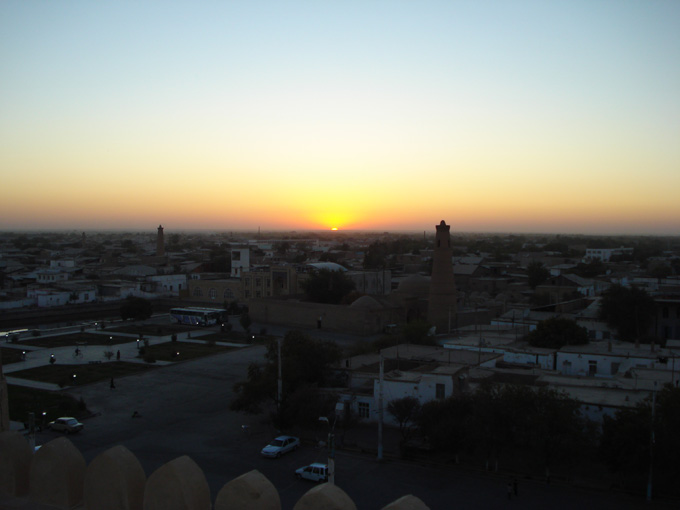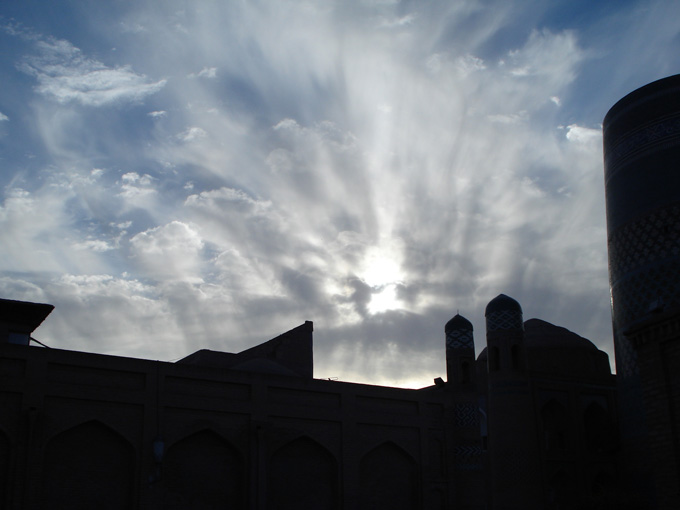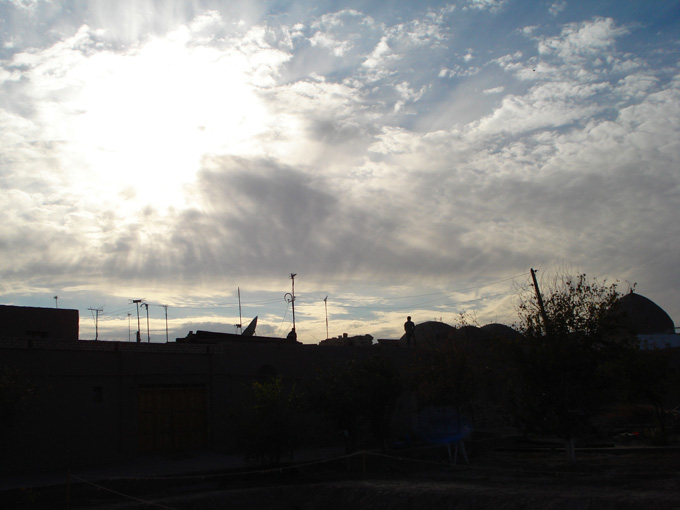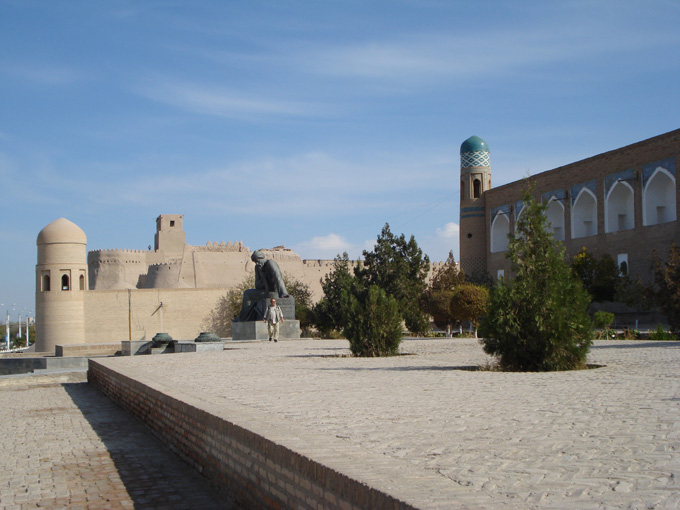 |
||||||||||||||||||||||||||||||||||||||||||||||
|
||||||||||||||||||||||||||||||||||||||||||||||
Khiva The ethymology of a word Khoresm causes various disputes. Some scientists declare that it has originated from the Iranian language - "Khuara" / "Khoarezm", that in translation means - sunrise, abundance of light. The matter is that the country was between two great deserts - Kyzyl Kum (red sand) and Kara Kum (black sand), and here it is possible to see, how goes up and down the sun. In other words above the traveller always was light. From the IX to XII centuries the capital of Khoresm is transferred to the city of Kunya-Urgench (to not confuse with new Urgench - regional capital of Uzbekistan). After semi-annual siege son of Chingishan commander Dzhuchi has ordered to disassemble a dam and to flood the plundered city. In 1598 capricious Amu Darya has changed current, having left old oases without irrigation and drinking water. The capital should be transferred on hundred fifty kilometers to the south where on caravan ways through sand of Kara Kum since olden days there was a fortress at well Kheyvak, become then a citadel of Khiva khanate. Nobody knows for sure, who and when erected Ichan Kala � internal fortress of Khiva. Archeologists date first fortifications by III-V centuries when Khoresm at government of Afrigid dynasty has found independence of power Persian Akhemenids, and then by skilful negotiations and owing to demonstration of military power has managed to avoid a gain of Alexander the Great. The strengthened settlement which has appeared in those days on caravan way to Merv could be connected with fresh well Kheyvak, on a legend dug by Simon - the son of the bible patriarch Noah. The sacred well has been preserved up to now in a northwest corner of Ichan-Kala among inhabited constructions. Today it is hidden under a brick dome, the top is decorated by sacral tugas - wooden poles, tied up by bright rags of fabric. Ten-meter walls of a fortress form oval perimeter in length in two and half kilometer. Defensive walls up to eight meters thick are constructed from mud blocks in diameter 40�40�10 centimeters. On all length they are supplied by a cogged border with narrow loopholes. Through each thirty meters are round defensive towers, and from four sides are entrance gates made from baked brick. These are already medieval extensions approximately dated by XIV-XV centuries, as well as the earliest cult constructions of shakhristan - internal city. In 1842 Allah Kuli Khan has finished erection around of external settlements of Khiva of a new fortification � Dishan Kala, extension is almost six kilometers. On that place, where from has been brought building material, was formed the lake Govukkul. And day in it people fishing and potters extract clay. External fortifications on which construction within three years worked two hundred thousand person, should protect capital of Khiva khanate from sudden attacks of Yomuds and other inhabitants of sand. The first attempt of Russian penetration into Khoresm has been made in 1717. Military expedition led by kabardian prince Berkovich-Cherkasskiy (before christening Davlet Giyer) tried to implement Peter's the I fantastic assignment - to turn the current of Amu Darya on ancient channel Uzboy to Caspian sea that the Russian military fleet could from Astrakhan reach Bukhara and India. Impossible adventure ended with that from the four thousandth group could escape home only 30 Cossacks, the others Khivinians have killed or have turned into slavery. In the spring of 1873 under command of Turkistan general-governor Konstantin Petrovich von Kaufman four troops in total number about 13 thousand people have acted in a campaign simultaneously from four directions - from Dzhizak through Kyzyl Kum, from Kazalinsk on coast of Aral Sea, from Mangyshlak through Ustyurt and from Krasnovodsk through Kara Kum. Borders of Khanate was not reached only southern troop, having stuck in quicksand. But the rest by May, 28th, after extreme difficulties of a campaign, from three sides have surrounded Khiva, having started to fire the walls and gates of Dishan Kala from artillery guns. Khan has secretly left capital on the grounds of Turkmen tribes by means of which expected to organize resistance, but, possibly, has felt, that yomud leaders can deprive him the authority much more likely, than Russian generals, and has soon returned, that on August, 12th in country garden at Gandemiyan gate to conclude the peace treaty. On conditions of the concluded peace Russian empire did not pretend for absorption of Khiva Khanate, leaving a throne to Mohammed Rahim-khan, also known, as poet Feruz. For it khan should recognize his self �obedient servant of Emperor All-Russia� and concede him all the grounds on the left coast of Amu Darya henceforth accessible to Russian navigation, with the right to organize there wharfs and a trading stations. All cities and settlements of khanate declared opened for Russian merchants without trading duties and other taxations. Besides in the territory of khanate were forbidden the slavery and human beings traffic that was officially declared the purpose of military campaign. In two hundreds years the country has appeared on fire of internal conflicts, which as a result has led to division of the state. On the basis of the Khorezm state has arisen Khivan khanate with capital Khiva. This time has coincided with development of the Great Silk Road, and the country was involved in trade relations with the Europe and Asia. In such kind khanate has existed five hundred years down to the beginning of the XX century. After the Great October revolution, on February, 2nd, 1920 has been proclaimed Khorezm National Soviet Republic. Khiva is divided on two parts - internal city is called "Ichan-Kala" (here lived khans, intelligency, priests, officials), it is surrounded by internal walls, actually is a citadel. Also there is an external city - "Dishan Kala" where other inhabitants of Khiva lived, and they were surrounded too with a wall (its rests were kept only here and there). Now in "Ichan-Kala" lives up to 300 families, basically all of them have been moved after October revolution. The citadel has territory in 26 hectares and has protective walls from 8 up to 10 meters in height. It is considered the State memorial estate in which ancient monuments and cultures are restored practically all. The city has four gates, but it is considered the main thing "Ota Darvoza" ("Father gate") through which tourists and visitors usually enter. The city Khiva is also a necropolis. There it is a lot of burial places. There are eminent people, and also simply inglorious. It is said, that khan of Khiva allowed burying only those dead men which relatives could cover a tomb with gold coins. Generally to live near to tombs - not very pleasant pastime. Though, all matter in habits and traditions. If the person eminent here is buried, to be near to it - is honourable, moreover, arises sensation of protection from spirit of this person. 02/09/2007 |
||||||||||||||||||||||||||||||||||||||||||||||
 |
||||||||||||||||||||||||||||||||||||||||||||||
 |
||||||||||||||||||||||||||||||||||||||||||||||
 |
||||||||||||||||||||||||||||||||||||||||||||||
 |
||||||||||||||||||||||||||||||||||||||||||||||
 |
||||||||||||||||||||||||||||||||||||||||||||||
 |
||||||||||||||||||||||||||||||||||||||||||||||
| -1-2-3- | ||||||||||||||||||||||||||||||||||||||||||||||